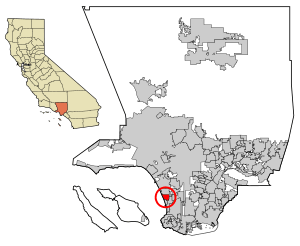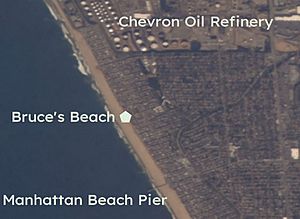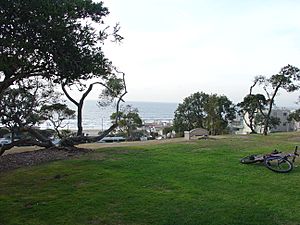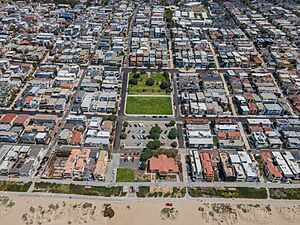Bruce's Beach facts for kids
Bruce's Beach was a special beach resort for African-American families in Manhattan Beach, near Los Angeles County, California. It was owned and run by Charles and Willa Bruce. Back then, in the early 1900s, there was racial segregation, which meant Black people were often not allowed to use the same beaches and places as white people. Bruce's Beach gave them a safe and fun place to enjoy the ocean.
The resort opened in 1912 and quickly became very popular. However, in 1924, the city of Manhattan Beach used a process called eminent domain to take the land. This means the government can take private property for public use, even if the owner doesn't want to sell it. The city said they wanted to build a public park, but many believed the real reason was racism.
For many years, the land remained empty. Later, in the 1960s, part of it became a park, and in 2007, it was officially named Bruce's Beach. In 2021, the Los Angeles County Board of Supervisors decided to return the land to the Bruce family's great-grandsons. This transfer was completed in 2022. In January 2023, the Bruce family chose to sell the beach property back to the county for $20 million.
The Start of Bruce's Beach

In 1912, Willa and Charles Bruce bought land near the ocean in Manhattan Beach. They paid $1,225 for it. They started a resort named after Mrs. Bruce. It had a lodge, a cafe, and a dance hall. This was very important because Black people had very limited access to beaches at that time. Other places where African Americans could go included Peck's Pier and a section of Santa Monica State Beach known as the "Ink Well."
Manhattan Beach was mostly a white community. The Bruce family's resort was a brave step against the rules of segregation. As more people moved to Los Angeles in the 1920s, and land became more valuable, Black residents faced more racial tension. Eventually, the city used eminent domain to force the resort to close.
Some people say a wealthy developer named George H. Peck helped Black visitors, but he also made it harder for them to reach Bruce's Beach. He owned land around the resort and put up "No Trespassing" signs, forcing visitors to walk an extra half mile.
In 1927, the city took control of the land from the Bruce family, saying it was for a city park. They tore down the buildings. The city also took other properties owned by Black families. The Bruce family sued for $120,000 but received a settlement of $14,500 in 1929. The land stayed empty for decades. In the 1960s, it finally became a city park. Later, in 1995, a part of the land, including the Bruce family's original lots, was transferred to Los Angeles County.
Bruce's Beach Park Today

In 2006, the city of Manhattan Beach decided to rename the park "Bruce's Beach." This was to show that the community understood its past and wanted to be welcoming to everyone. In March 2007, the park was officially renamed in a special ceremony.
The park is on a hill overlooking the ocean. It has grassy areas, benches, and small trees. It's located between 26th and 27th Streets.
On June 19, 2020, a Juneteenth celebration was held at Bruce's Beach park. Juneteenth celebrates the end of slavery in the United States. A resident named Kavon Ward organized the event to bring attention to how the land was taken from the Bruce family. She wanted the land to be given back to them. After this event, Ward started a group called Justice for Bruce's Beach. They held rallies and marches to pressure the city to return the land.
In October 2020, the city council created the Bruce's Beach Task Force to study the issue. This group faced some opposition from anonymous residents. The task force recommended that the city apologize to the Bruce family. Some city council members were worried an apology could cause legal problems for the city. In the end, the city council approved a statement that "acknowledged, empathized, and condemned the city's role in the racially motivated condemnation of properties in the area known as Bruce's Beach." This means they recognized the city's past actions were wrong and driven by racism.
The city also worked on updating a plaque at the park to tell the story of Bruce's Beach. After some discussions, the city council approved new words for the plaque in March 2022. It explains how Willa and Charles Bruce created the resort in 1912 for the Black community. It also mentions other Black families who bought land there. The plaque states that the Bruce family and other Black property owners faced harassment and discrimination. It clearly says that the city's action to take the land was "racially motivated and wrong." It ends by saying, "Today, the City acknowledges, empathizes, and condemns those past actions. We are not the Manhattan Beach of one hundred years ago. We reject racism, hate, intolerance, and exclusion."
Land Returned to the Bruce Family
In April 2021, Los Angeles County officials began the process to return the land to the Bruce family. Janice Hahn, a member of the Los Angeles County Board of Supervisors, led this effort. On April 20, 2021, the Supervisors voted to approve returning the county land to the family's descendants.
Because of how the land was transferred over the years, there was a rule that Los Angeles County had to use Bruce's Beach for public recreation and couldn't sell or transfer it. To change this, the California State Senate approved a bill in June 2021, allowing the land to be returned. Governor Gavin Newsom signed this bill into law on September 30, 2021.
By May 2022, it was confirmed that Marcus and Derrick Bruce were the great-grandsons and legal heirs of Willa and Charles Bruce. On June 28, 2022, the Los Angeles County Board of Supervisors voted to officially return the two oceanfront parcels to the Bruce family.
On January 3, 2023, Los Angeles County officials confirmed that the Bruce family decided to sell the land back to the county for $20 million.



